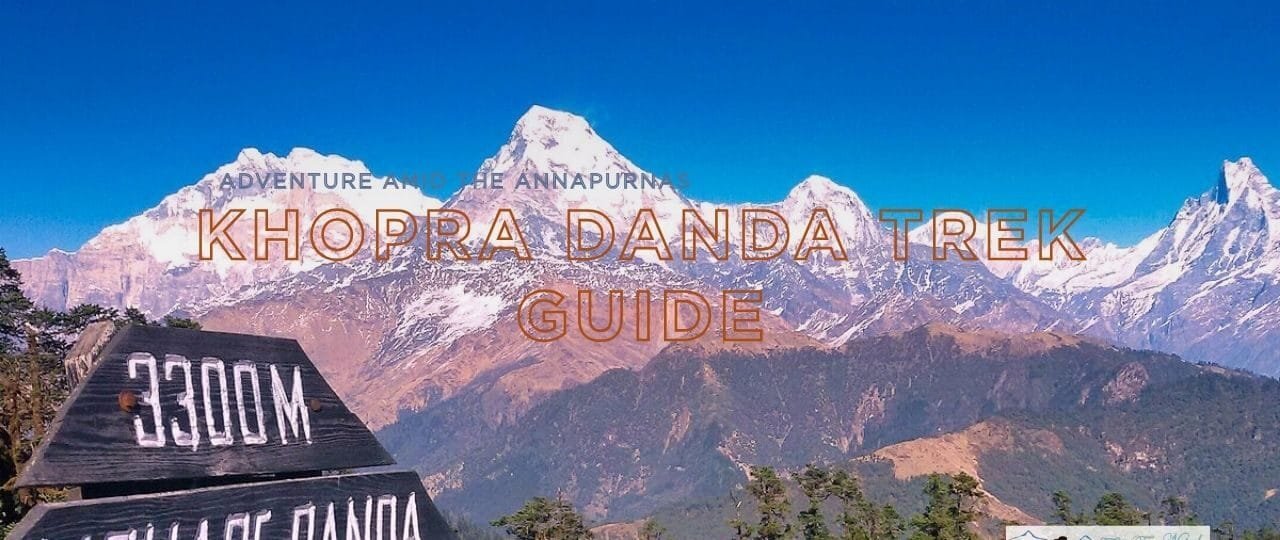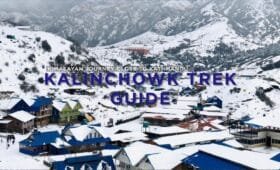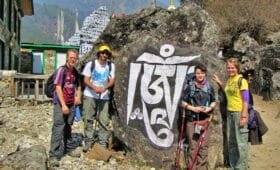The Khopra Danda Trek has recently emerged as one of Nepal’s most alluring short treks, offering glorious Himalayan vistas without the crowds that flock to well-known trails like Annapurna Base Camp. Also referred to as the Khopra Ridge Trek, this route ascends a pristine vantage point known as Khopra Danda. Perched above deep valleys and near-vertical hillsides, you’ll witness commanding views of Dhaulagiri, Annapurna South, and Nilgiri. But the journey is more than just a spectacular panorama. It’s also a cultural immersion, weaving through local Gurung and Magar villages amid terraced farmlands and rhododendron forests.
This comprehensive Khopra Danda Trek Guide article delves into the trek Itinerary, including cost, route details, difficulty, weather, and how to merge your trek with philanthropic travel via Volunteers Initiative Nepal (ViN). Whether you’re new to trekking or an experienced hiker seeking a less-trampled trail, the Khopra Danda Trek is a gem in the Annapurna region—accessible, visually stunning, and ripe for cultural discovery.
Introduction
1. Introduction: Why Opt for the Khopra Danda Trek?
The Khopra Danda Trek is ideal for those craving off-the-beaten-path experiences without exceeding moderate altitudes. While popular routes like Poon Hill or Annapurna Base Camp can host masses of trekkers in peak season, the Khopra Ridge Trek retains a more serene setting. Often overshadowed by more prominent names, Khopra Danda—rising about 3,660 meters—reveals 360-degree Himalayan vistas usually attainable only through heftier journeys.
Statistic: According to the Annapurna Conservation Area Project (ACAP), more than 100,000 trekkers visited the Annapurna region last year. Only a tiny fraction ventured specifically for the Khopra Danda Trek, keeping it less congested. This difference shapes a more immersive Himalayan environment, blending raw scenic grandeur and unfiltered local hospitality.
“The Khopra Danda Trek was a revelation—like a private balcony seat to Annapurna and Dhaulagiri, minus the traffic jam of more famous routes,”
says Linda, a 29-year-old trekker from Sweden.
Cultural Overview
2. Cultural & Environmental Setting
Most of the Khopra Danda Trek route lies within the Annapurna Conservation Area (ACA)—Nepal’s most significant protected zone. You’ll typically begin in lower farmland thick with terraced fields of millet and rice, ascend rhododendron forests vibrant in spring, and culminate at the Khopra ridge, offering a vantage to see multiple eight-thousanders.
Culturally, you traverse villages of ethnic Gurung and Magar communities. Traditional lifestyles revolve around agriculture, livestock, and seasonal trade. Local teahouses adopt a family-run approach, letting you dive deeper into daily chores, regional cuisines, and the region’s spiritual identity. Many villages feature small shrines or communal corners decorated with prayer flags—especially near vantage points or rest stops.
Trek Itinerary
3. Core Highlights of Khopra Danda Trek Itinerary
A typical Khopra Danda Trek Itinerary can range from 7–10 days, depending on side trips or your chosen route. Below is a representative 9-day schedule:
Day 1: Drive Pokhara → Nayapul (~1 hour), Trek to Ghandruk (~1,940m)
Gentle hike (3–4 hours). Ghandruk is a large Gurung village known for its cultural museums and vantage points in Annapurna South.
Day 2: Ghandruk → Tadapani (~2,630m)
~4 hours uphill through lush forests. Early glimpses of Annapurna and Machhapuchhre.
Day 3: Tadapani → Dobato (~3,420m)
A tranquil route crossing rhododendron forests. Dobato is smaller, with fewer teahouses.
Day 4: Dobato → Khopra Danda (~3,660m)
The route ascends a ridge, culminating in open meadows near the Khopra Ridge Trek viewpoint. Expect 5–6 hours of trekking.
Day 5: Explore Khopra Danda (Option: Khayer Lake side trip)
Optional day hike to Khayer Lake (~4,600m) for dramatic vistas. The extension can be strenuous but rewarding.
Day 6: Khopra Danda → Swanta (~2,200m)
Descending from the ridge. Swanta is a peaceful Magar village, typically 4–5 hours away.
Day 7: Swanta → Ghorepani (~2,874m)
A moderate trek linking the popular Poon Hill route if desired.
Day 8: Ghorepani → Poon Hill (~3,210m, sunrise) → Hike to Tikhedhunga (~1,540m)
Early morning vantage of Dhaulagiri, Annapurna. Then, a descent of 1,600+ meters in a single day.
Day 9: Tikhedhunga → Nayapul → Drive to Pokhara
~3 hours final walk, plus ~1 hour drive to Pokhara.
Khopra Danda Trek Duration might shorten to 6–7 days if skipping side expansions or Poon Hill. Meanwhile, more leisurely itineraries extend to 10+ days with extra cultural stops or rest days. The highlight remains the dawn and dusk panoramas from the ridge.
Trek Cost
4. The Khopra Danda Trek Cost
Khopra Danda Trek Cost compares closely to typical short Annapurna treks, yet note variables:
- Transport
- Pokhara-based approach. Bus or private jeep to Nayapul ~USD 10–30 depending on group size.
- Permits
- Annapurna Conservation Area Permit (ACAP) ~USD 30.
- TIMS Card ~USD 10–20.
- Food & Lodging
- Teahouses: ~USD 3–8 per room nightly.
- Meals: ~USD 20–25 daily. Higher altitudes see steeper menu prices.
- Guide & Porter (Optional but recommended):
- A Khopra Danda Trek Guide ~USD 25–30/day. Porter ~USD 15–25/day.
- Misc
- Hot shower (~USD 2–4), Wi-Fi (~USD 2–5), and device charging (~USD 1–2).
Hence, a 7–9 day trek might cost ~USD 400–600 if going minimal. An agency’s Khopra Danda Trek Package, covering transport, guide, and partial meals, might cost ~USD 700–1,000. With better or lodge upgrades, budget a bit more.
Trek Map
5. Route Visualization: Khopra Danda Trek Map
A Khopra Danda Trek Map typically covers:
- Nayapul (~1,070m): Usual gateway after a short drive from Pokhara.
- Ghandruk (~1,940m) or alternative starting points like Kimche if wanting shorter hikes.
- Dobato (~3,420m): Ascending forest-laden ridges.
- Khopra Danda (~3,660m): The trek’s apex vantage, overshadowing the Annapurna & Dhaulagiri Massifs.
- Swanta (~2,200m): Peaceful farmland as you descend.
- Ghorepani (~2,874m): A junction connecting the Poon Hill route.
- Poon Hill (~3,210m): A famous vantage easily integrated as a side trip.
Khopra Danda Trek The Distance from Ghandruk to Khopra Ridge and onward to Ghorepani is ~40–50 km, depending on side loops. The daily ascents rarely exceed 600–800m, though cumulative climbs add up across multiple days. A day hike to Khayer Lake can add 6–7 hours and push altitudes to ~4,600m for those seeking an extra challenge.
Trek Difficulty
6. Understanding Khopra Danda Trek Difficulty
Khopra Danda Trek Difficulty sits at moderate. Key aspects:
- Altitude: ~3,660m at Khopra Danda. Some optional expansions (Khayer Lake ~4,600m) push it near advanced territory.
- Steep Climbs: Ascents from Ghandruk up to Dobato or the final ridge can be physically demanding.
- Weather: As with any Himalayan trek, inclement conditions or slippery trails matter.
- Teahouse Options: Lodging is mostly comfortable. The route is less crowded, ensuring a tranquil environment.
Trekkers with moderate fitness typically handle it mainly if they schedule a rest or a half-day around Ghandruk or Dobato for altitude adaptation. Each day generally involves ~5–6 hours of walking.
Trek Weather
7. Best Seasons & Khopra Danda Trek Weather
Khopra Danda Trek Weather typically follows Annapurna norms:
- Autumn (Sept–Nov)
- Crisp skies, stable days. Minimal precipitation, near 20°C at lower altitudes, sub-zero nights above 3,500m. The busiest season for trekking.
- Spring (Mar-May)
- Rhododendrons ablaze, moderate day temps (~10–15°C around Khopra ridge). Occasional afternoon storms.
- Winter (Dec–Feb)
- Sub-zero nights near Dobato or Khopra. Fewer trekkers. Some teahouses might close. Crisp views if you handle the cold.
- Monsoon (Jun–Aug)
- Daily rains hamper roads, slippery trails, and leech presence in lower altitudes. Fewer visitors and lush farmland exist, but cloud cover might hamper mountain glimpses.
Khop’sra Danda Trek’s Best Time is typically autumn or spring. Winter is feasible for solitude-lovers prepared for chilling nights. Monsoons see vivid greenery, but it is more challenging to see consistent mountain vistas.
8. Khopra Danda Trek Permits & Paperwork
For the Khopra Danda Trek:
- Annapurna Conservation Area Permit (ACAP) (~USD 30).
- TIMS Card (~USD 10–20).
- If linking with more recognized areas (e.g., ABC), additional fees might apply (though typically ACAP covers it).
Carry passport copies and 2–3 passport photos for easy processing in Pokhara or Kathmandu. If you choose a Khopra Danda Trek Package, your agency typically handles these. Keep your permits on you in case rangers or local checkpoints ask.
Trek Accommodation
9. Accommodations: Khopra Danda Trek Accommodation
Khopra Danda Trek Accommodation revolves around teahouses, homestays, and a few specialized community lodges:
- Teahouses
- Found in Ghandruk, Tadapani, Ghorepani, among others. Basic but comfortable rooms, shared bathrooms, and communal dining.
- Community Lodge
- A unique highlight near Khopra Ridge. Operated by local committees, ensuring tourism revenue channels back to the village’s projects, e.g., schooling or sanitation.
- Facilities
- Expect more spartan rooms, limited hot showers, and varied meals (dal bhat, noodles, momos). The ridge area might have minimal Wi-Fi or solar charging.
While it’s not as remote as certain altitudes, the route is less commercial than ABC or Poon Hill. So, advanced booking during peak seasons is recommended if you want prime vantage-located lodgings.
FAQs
10. The Most Frequently Asked Questions
Below are the top queries often popping up about Khopra Danda Trek:
How many days is the Khopra Danda Trek Duration?
Usually 7–10 days, though expansions to Khayer Lake or integrating Poon Hill can add 1–2 days.
What is the Khopra Danda Trek Difficulty?
Moderate. The highest altitude is near ~3,660m, or ~4,600m if you do the Khayer Lake side trip. It is generally suitable for anyone with basic fitness.
How much does the Khopra Danda Trek Cost?
~USD 400–600 if minimal, more if hiring a guide/porter. A Khopra Danda Trek Package might be ~USD 700–1,000 for a 7–9 day route with some meals, transport, and lodging included.
What is the best time for the Khopra Danda Trek?
Autumn (Sept–Nov) or spring (March). Winter is quiet but cold, and the monsoon brings lush greenery but potential clouds and leeches.
Do I need any special Khopra Danda Trek Permits?
There is only the ACAP (~USD 30) and TIMS (~USD 10–20). No restricted permit is required.
Is a Khopra Danda Trek Guide mandatory?
It’s not mandatory but recommended for local insights, altitude pacing, and route guidance, especially if exploring lesser-known side trails like Khayer Lake.
How difficult is the Khayer Lake side trip?
Steep. Gains ~800–1,000m in a single day. Some do it as a round day hike from Khopra, so good fitness and an early start are needed.
Trek Reviews
11. Gathering Khopra Danda Trek Reviews & Success Stories
Jane’s Experience
Jane, a 28-year-old trekker from Australia, enthused about the “unparalleled quietness” on the Khopra Danda Trek. After finishing the ridge climb, she marveled at the panoramic site:
“No crowds, just a handful of trekkers, plus surreal glimpses of Dhaulagiri. I spent hours watching clouds drift around the peaks—it was magical.”
Local Perspective
Local lodge owners near Khopra Danda highlight that tourism fosters communal empowerment. Revenue from the community lodge supports local health facilities and education. The region’s transitional farmland (like Swanta or Chistibung) also benefits from travelers purchasing homemade cheese or produce.
Khopra Danda Trek Reviews consistently reflect the route’s synergy of convenience (less altitude, moderate difficulty) and majestic mountain immersion rivaling the Annapurna circuit. Negatives revolve around occasionally limited lodging or the steep single-day expansions to Khayer Lake.
Trek Route Variations
12. Potential Side Trips & Khopra Danda Trek Route Variations
Khopra Danda Trek Route can integrate the following:
- Khayer Lake (~4,600m)
- It is a demanding day hike from Khopra Ridge. It is an ancient pilgrimage site revered by local Hindus and Buddhists.
- Ghorepani & Poon Hill
- Many link the route with an early sunrise vantage at Poon Hill (~3,210m).
- Ghandruk Loop
- Some start or end in Ghandruk, exploring its cultural museum and local handicraft centers.
Khopra Danda Trek The Distance from Ghandruk to Khopra Ridge, onward to Ghorepani, and out to Nayapul is ~50–60 km. A daily 5–7–hour walk is typical and feasible for novices if they maintain moderate fitness. The route can also optionally rejoin the main ABC route if you crave a more significant extension.
Trek Tips
13. Additional Khopra Danda Trek Tips for a Fulfilling Journey
13.1 Physical Preparedness
- Cardio & Stamina: Light running, biking, or brisk walking for ~6 weeks before.
- Altitude Acclimatization: The route’s max altitude is ~3,660m, typically manageable, but if you do the Khayer Lake side trek (~4,600m), plan an extra day.
13.2 Minimizing Environmental Impact
- Carry Reusable Water Bottles: Use boiled or purified water, not single-use plastics.
- Respect Village Boundaries: Tread gently in farmland; ask before photographing locals.
- Pack Out Trash: Disposal can be difficult in remote ridges.
13.3 Caution with Weather & Gear
Trekking Poles: Help on steep ascents and descents, especially near rocky edges or if muddy after monsoon.
Khopra Danda Trek: The Weather can be unpredictable at the ridge. A down jacket, gloves, and beanie are wise.
Conclusion
From Ghandruk’s cultural heartland to the crowning vantage of Khopra Danda, the Khopra Danda Trek merges mesmerizing Himalayan backdrops with an intimate glimpse into local Gurung and Magar life. Each day reveals new facets—mist-shrouded forests, precarious ridges, and eventually, the jaw-dropping Himalayan lineup: Dhaulagiri, Annapurna South, Machhapuchhre, and more. Meanwhile, cozy teahouses and communal lodges underscore a sense of shared adventure.
Engage in “Double Impact” Trekking
By trekking with Volunteers Initiative Nepal (ViN), you convert your travel into a philanthropic mission. Their charity trekking and travel tours funnel all proceeds into community empowerment, ensuring the Khopra Danda Trek fosters not only your enrichment but also local progress:
- Share: Encourage your circle of friends, family, or social media audiences to adopt philanthropic travel and spread positive transformations across the Himalayas.
- Volunteer: Contribute your time or skills to health, education, or environment projects near the route’s villages.
- Intern: Combine academic or professional goals with on-ground, community-driven solutions.
- Donate: Support micro-initiatives that supply local schools or enhance basic healthcare.
Namaste—and let your footprints over the ridge unify personal adventure with local empowerment, forging a better future for travelers and mountain communities.
Additional Info
Extended Info & Final Encouragement
1. Seasonal Overviews
- Autumn (Sept–Nov): Clear vistas, moderate temperatures, nights near freezing around Khopra Danda, the busiest season.
- Spring (Mar-May): Rhododendron bloom, mild daytime ~15–20°C in lower altitudes, occasional storms. Crisp mountains in the morning.
- Winter (Dec–Feb): There are sub-zero nights near the ridge, fewer trekkers, and some lodges might shut down. However, if you manage the cold, this is good for solitude.
- Monsoon (Jun–Aug): Lush greenery, frequent rain, leeches in the forest, occasional flight/road disruptions, risk of hazy mountain glimpses.
2. Variation Linking Poon Hill & Khopra
You can do a loop: Ghandruk → Tadapani → Dobato → Khopra Danda → Swanta → Ghorepani → Poon Hill → Nayapul. This synergy merges iconic vantage points. The trip typically takes 7–9 days, slightly longer if you do the Khayer Lake side trek.
3. Potential Challenges
- Altitude: ~3,660m is moderate, so mild symptoms can occur if you ascend too fast. A day’s rest near Dobato helps.
- Steep Descents: The route from Khopra Ridge to Swanta or Ghorepani to Tikhedhunga can drop 1,000m+ daily. Trekking poles are recommended.
- Infrastructure: While teahouses exist, they may be limited. Book or arrive early, especially in peak season.
4. Post-Trek Experiences
After returning to Pokhara, many enjoy:
- Lakeside Relaxation: Phewa Lake boat rides, lakeside cafes.
- Local Adventures: Paragliding, zip-lining, or a gentle half-day in Sarangkot.
- Volunteering: Additional stints in region-based or Kathmandu-based community projects via ViN.
By culminating your Khopra Danda Trek in philanthropic synergy—whether volunteering or donating—you align your wanderlust with beneficial outcomes for remote communities. It’s more than a scenic climb; it’s a chance to foster a better tomorrow in the Himalayas.
5. Summation
The Khopra Danda Trek, or Khopra Ridge Trek, weaves mesmerizing altitude meadows, lesser-trodden trails, and panoramic ridgeline vantage points overshadowing legendary Himalayan summits. An alternative to mainstream Annapurna routes, this itinerary typically spans ~7–9 days, culminating around 3,660m or up to ~4,600m at Khayer Lake. Mildly challenging, it’s feasible for those with essential trekking experience, especially if you plan a rest day for acclimatization.
Khopra Danda Trek Cost is moderate, with typical teahouse lodging and optional side expansions. The route’s intangible gifts—unique vantage angles of Dhaulagiri and Annapurna, plus warm local lodges—forge an experience both fulfilling and humane. By trekking with ViN, you convert this Himalayan journey into “double impact” travel, ensuring each step uplifts local families. Embrace the synergy of altruism and adventure, forging cherished memories that echo beyond the mountaintops.




